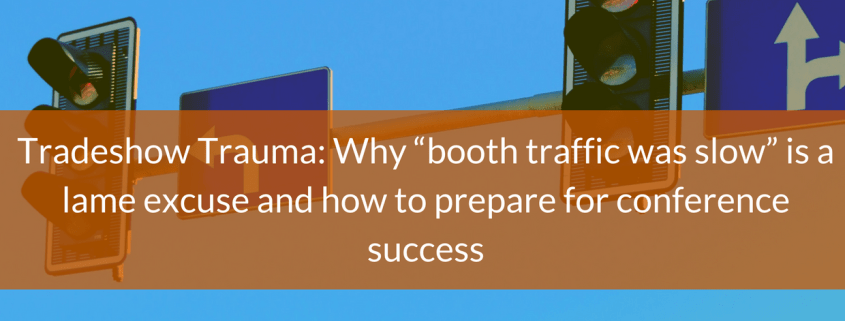
by Lisa Chernikoff | Jan 3, 2018 | Blog
As a marketing and PR professional who has spent countless hours in tradeshow booths and walked more than 20,000 steps at the HIMSS conference while wearing heels, I’ve experienced both the glory and the defeat of being an exhibitor. And while there is no better feeling than packing up your boxes, tearing down the booth and heading home after a job well done, there is also no greater pain than realizing that your company’s precious time and resources were virtually wasted because your conference strategy fell short.
After every tradeshow, it’s common to speak with exhibitors who complain that “booth traffic was slow” and cite that reason as the root of their conference failure. But let’s be honest — that’s a lame excuse. It’s the easy way out to blame poor performance at the show on exhibit hall organizers rather than reflecting on how your team may be at fault, or at least largely contributed to the problem.
In fact, upon much-needed reflection, those complainers would see that they are likely committing the cardinal sin of tradeshow marketing. They’re only focused on the conference. They’re not focused on the holistic strategy that enables the smartest, more successful companies to succeed at conferences again and again and again.
To avoid this tradeshow trauma and emerge triumphant in 2018, it’s critical for companies to have a three-pronged approach that includes not just a conference strategy where you show up and wait, but also and even more importantly a pre-conference strategy and a post-conference strategy.
Here are 4 insider secrets to help you get started:
#1 Never rely on booth traffic
Sure, booth traffic is nice and we all want it but it’s even better to drive traffic to your booth in advance. As savvy marketing professionals know, the best tradeshow marketing strategies start early and establish a regular cadence of communication. Most companies find that implementing a targeted email campaign starting 6 weeks in advance of the show is ideal but some may find that 8 weeks or 4 weeks works best for their audience.
These emails should be geared to both sales prospects to schedule meetings or demos and current clients to have a face-to-face touchpoint and determine cross-sale opportunities. As always, the top-performing emails are brief and targeted to attendees by role and job setting. It’s also best to have a form where attendees can schedule time and then receive a confirmation with a calendar invite. Why is that so important? It gets you on attendees calendars before they arrive at the show and are overwhelmed. Also, then your team can send them reminders about the scheduled slot or reach out if they don’t arrive as planned.
#2 Winning is great but winning isn’t everything
Pre-conference email campaigns can also invite attendees to activities in the booth such as speaking events or games instead of just meetings and demos. They can also offer attendees “a chance to win” and highlight big prizes, but they must not rely on the allure of a gimmick alone. There are few too many promotions for your giveaway to break through the noise. A pre-conference strategy that shares quality content, in addition to touting “a trip for 100 around the world” is the safest, most effective way to not only illustrate thought leadership but also to create brand awareness of your company as leader and innovator that offers far more than just a chance to win ““ but rather real ROI.
#3 Think like an attendee
Spoiler alert for those many hours spent in the booth. Nobody wants your marketing brochure! It will end up in the next trash can even if they take it, and if it makes it back to their room, it will end up in the hotel trash can. They also really don’t want a folder with multiple product one-pagers and a recent press release about your new product. Please note that this realization also spares your marketing team and admin hours of folder stuffing. Yes, you’re welcome.
The big idea here is to remember why attendees are at the conference. Most attendees are there to learn, not to purchase your “ground-breaking, best in class, fully integrated solution.” So, give them what they want like client case studies with real-world insights and thought leadership that demonstrates your knowledge and unique perspective. That’s the true value proposition that won’t get throw in the trash.
#4 Follow-up, follow-up, follow-up
It’s great to have a successful show, but it’s what companies do afterwards that matters most. It’s all about the follow-up communications, which should include a series of e-blasts, with the first prepared ahead of time and sent within 1-2 days of show close. The post-show e-blast should provide an opportunity to continue to engage with your company by downloading a new piece of content, registering for a webinar, or scheduling a full product demo for their broader team. However, the e-blast is not enough. To see results, it must be complimented by personalized follow-up from the sales team where there is even a small percentage chance of generating new pipeline. Without this timely and dedicated post-show communications, it’s impossible to reap the benefits of your hard work pre-show and at the show.
Remember, it doesn’t matter how many people attend the tradeshow. Only that the right people make it to your booth.
Instead of leaving success to chance, put together a three-prong plan that will tip the odds in your favor. It sure beats coming up with lame excuses later.
by Julie Donnelly | Dec 20, 2017 | Blog
Clients often wonder how a PR agency can get reporters to read email pitches. It’s basically a combination of art, science, and alchemy definitely not for the faint of heart.
When I was the healthcare reporter for the Boston Business journal, I got an average of 300-400 emails per day. In the run up to a major conference, such as JP Morgan or HIMSS, that number could easily reach 500 emails per day. I couldn’t possibly read them all. I deleted more than half, and immediately read about a quarter of them. The rest I saved to read later. Maybe.
4 ways to lose a reporter in 70 characters
The biggest mistake you can make is failing to take advantage of the subject line to quickly convey the value of the company, product, CEO, or scientific advance. Here are a few common types of subject lines that won’t get reporters to read pitches:
- “Heads up, big news from Health Inc.” – A lot of companies waste valuable space in a subject line with phrases designed to get reporters attention. “Heads up” is really useful only if you are a TV cameraman reviewing video and the President walks into the room. Simply state the news, in the format, “Who is doing what and why.”
- “Introducing CEO Bob Smith“- A lot of companies write to offer the expertise of their thought leaders, and that’s great. But this doesn’t give me any information about Smith’s areas of expertise, or whether he’ll be a candid, interesting or thought-provoking interview. Give the reporter some insight into your expert’s point of view and, if possible, his or her personality.
- “Health Inc. tops sales projections for the third year running” – This kind of blatant promotion will immediately be deleted by most reporters. First of all, where’s the story there? Secondly, whose projections are we talking about, the company’s? Reporters need independent numbers.
- “Health Inc. to revolutionize health care“- Subject lines that are intentionally vague or seek to tease the reporter and pique their interest can backfire. This particular one is too broad and strains credulity. I would probably give it a pass. It may be necessary to keep the news under wraps until, for instance, a reporter agrees to an embargo. But try to give as much detail as possible, so he or she can make an informed decision.
2 ways to lose a reporter once they are on the hook
OK, so you’ve survived the subject line gauntlet, and the reporter has clicked on your email. The next challenge is to get him or her to read the whole pitch, or most of it, and call for an interview. Here are a few Don’ts:
- Don’t overload the reporter with background – Keep it simple. A two- to three-line pitch explaining what the news is and why it’s important is best.
- Don’t abuse embargoes -Embargoes may be necessary for a variety of reasons for instance, the news is tied to a JAMA article that has not yet been published. But putting an embargo on news to try to inflate its value may backfire. Reporters are willing to abide by embargoes as long as everyone is on the same playing field with the same rules.
If you can avoid these six pitfalls you will be well on your way to hearing the sweet sound of your phone ringing with reporter interest.
Have you ever fallen prey to one of these pitfalls? Do they ring true? What other pitching best practices have you discovered?

by admin | Dec 14, 2017 | Blog

by Todd Stein | Dec 13, 2017 | Blog
Introducing Hackonomics,” the campaign hinged on a report conducted by RAND (sponsored by Juniper) about the hidden economy of the hacker universe. Juniper wanted to take a fresh look at hackers to reveal the motivations and operations of the hacking community. The result was a first-of-its kind economic analysis of the cyber black market and the impact it had on targeted businesses.
Juniper built an integrated campaign that leveraged PR, marketing, government relations, sales and digital and social media. Tactics included webinars, a new website dedicated to the campaign, online ads and social media initiatives. Juniper briefed policymakers, made the report freely available in 10 languages, and distributed it across RAND’s customer base.
Here are two of the most creative elements of the campaign:
- Juniper illustrated the complexity of the hacker market by drawing the comparison to a thriving metropolis, highlighting its interconnectedness. An interactive presentation enabled viewers to see the hierarchical job functions, businesses, schools and even law enforcement roles held by active members of the cyber black market.
- An interactive timeline highlighting notable milestones and hacks over the years was shared with the cybersecurity community ahead of the report’s release to encourage conversation. Brilliantly, Juniper intentionally left key milestones off the timeline, which encouraged community members to contribute their own milestones and share the history of security hacks more broadly among their contacts.
According to Juniper, the campaign nearly doubled its share of voice over a three-month period thanks to 17,000 blog views, 1,250 executive summary downloads, and over 300 global articles, including feature placements in newswires, as well as the Financial Times, Bloomberg, The Wall Street Journal and The Daily Telegraph (UK).
Hijacking the Super Bowl
The second cool PR campaign is one of the most creative and effective uses of a limited budget that I’ve seen. In 2015, Volvo was preparing to launch a new, updated version of its XC car amid slumping sales and stiff competition from larger, more popular brands like Mercedes Benz, BMW and Lexus.
Looking for ways to tap into an affluent, millennial audience, Volvo hit on the upcoming Super Bowl, whose audience fit the mold. But the carmaker’s budget for the product launch was enough for only about one-third of one second of Super Bowl airtime.
Their solution is a textbook example of hijacking the “Volvo Interception” campaign.
While their competitors lined up to buy multi-million dollar ads for the big game, Volvo began using its social channels, other ad buys, and traditional media relations to spread the word about its campaign.
The idea was simple: Every time a competitor’s ad was broadcast during the Super Bowl, viewers using the hashtag #VolvoContest on Twitter could nominate someone to win a one of 5 new Volvo XC60s.
It worked brilliantly. The Interception campaign drove 70 percent year-over-year sales increase for the XC60. That was the highest February boost in the car’s history. The hashtag was tweeted over 55,000 times, more than any other auto-related hashtag.
The Interception campaign achieved great results by capitalizing on other brands, effectively stealing their attention and breaking through the noisiest media day of the year.
Creativity Trumps Relationships
You’ve heard it before: PR is all about relationships. It’s a tired phrase but still true. Success hinges on having a solid working relationship with key journalists, analysts and influencers.
But even more important than relationships is the ability to craft a creative pitch or campaign from a hodgepodge of information about your client their market position and history, competitive differentiators, target audience, audience influencers, budget, and a million other factors.
As the Juniper and Volvo examples show, creativity trumps relationships, and in many cases can even overcome extremely limited budgets.
The examples also illustrate the power of integrated campaigns. Combining social media, traditional media relations, marketing and advertising can exponentially magnify the impact of a good idea.
What great ideas in marketing or PR have you seen?

by Brandon Glenn | Dec 6, 2017 | Blog
A recent webinar sponsored by Cision explored several changes in media relations over the last few years and offered tips on steps healthcare IT (HIT) organizations should take to prosper in this new reality.
The webinar was led by Michael Smart, a PR pro who says he has trained more than 7,000 communicators in his career, and is based on a white paper he wrote. Smart notes that, in his own observations, he’s seen far too many organizations chase the “Holy Grail” of coverage in the New York Times or Wall Street Journal to the detriment of smaller, lesser-known publications that in some cases could deliver even more value to clients.
Refreshingly, Smart also offered among the sharpest denunciations I’ve come across of the corporate scourge known as multi-tasking, stating, “I hate multitasking. It’s this thing we were all excited about 10 years ago until we realized it’s awful, much like kale. I seriously think it destroys potential and it’s killing a lot of PR pros, and so I’m on a mission to defeat it.”
Amen, though I will admit to enjoying kale in the proper context. To Smart’s comments, I’d like to add my own sarcastic slogan for multitasking, to be emblazoned across inspirational posters hung above the busy cubicles of America: “Multitasking: Why do one thing well when you can simultaneously do 10 things poorly?”
While many of the changes in media relations that Smart describes will be familiar to PR veterans, a refresher never hurts. In that spirit, I attended the hour-long webinar and condensed the five key points down into this quick, bite-sized summary.
- Expand your definition of the “media” in “media relations” to include any third-party trusted by your audiences: In other words, explore nontraditional outlets that may be easier to work with and have similar reach and credibility to the old guard. This can include well-known and widely read sites like Vox that have only been around for a few years, or even corporate blogs. The key is simply whether the site has earned your desired audience’s trust. How do you know which of these sites are worth pursuing? Start by using SimilarWeb to research site traffic and use Moz to examine domain authority.
- Journalists incentives have changed. They must increasingly focus on web traffic: Again, no shocker here for anyone who’s been paying attention. But this new reality opens up new possibilities for HIT organizations. Smart suggests that journalists will be more receptive to your pitches if you can show you’ll be able to distribute their content to a wider audience yourself, ideally by leveraging a social account with a lot of followers or an email newsletter, for example.
- Get noticed before you pitch: All experienced marketers know that journalists will be more receptive to their pitches if they’ve been able to previously establish solid working relationships with those journalists. But Smart offers good advice for establishing those relationships, which are especially important given that there are four PR pros for every professional journalist in the U.S. and U.K., according to statistics he cited during the webinar. He suggests developing a key list of 10 influencers, and then devoting 10 minutes per day to reading content they’ve produced, and when appropriate, reacting to the content with a compliment or a few kind words. He touts this as a simple daily task to “dramatically” increase your response rate. A private Twitter list is a great way to keep up-to-date with content from your top influencers.
- Faux customization often fails: Specific and sincere customization can help you stand out. Smart warns to avoid beginning pitches with broad, non-personalized statements. As supporting evidence for journalists frustration with this approach, Smart cites data from Cision’s 2017 State of the Media Report. When asked to improve the situation, journalists two most frequently cited pieces of advice were, first, to research and understand the media outlets they’re pitching, and second, to tailor their pitches to suit those outlets.
- Journalists don’t have time to do the legwork anymore: Reporters are always on deadline. They don’t have as much time as they once did to research sources or story ideas and they have an “insatiable need for visuals,” which can often be hard to acquire, according to Smart. The big change here is how much of this unglamorous legwork journalists will let HIT organizations do for them once they’ve proven to be trustworthy and credible, Smart says.
No doubt the practice of media relations will continue to change just as quickly as the media ecosystem itself does. But HIT organizations looking to keep pace with this evolution would do well to try implementing some of Smart’s advice. Smarter, more targeted pitching could help free us of our quality-killing, attention-sapping multitasking obsession.

by Stephanie Janard | Nov 29, 2017 | Blog
One of these days I’m going to put together a sort of “Road Warrior Olympics,” in which contestants compete on how well they can conduct business while riding in an Uber, going through security at the airport, and even in the midst of the plane’s takeoff and landing. That’s how impressed I am with the multitasking skills of the thought leader healthcare executives I regularly interview for various writing projects. I probably have more interviews with people driving to the airport than I do while they’re in an actual office building.
Just last week, I interviewed the CEO of an operating room analytics company while his Uber driver took him to Heathrow. Just as he was arriving at the airport, he discovered his flight was actually leaving from a different airport. He was only momentarily at a loss for words then crisply told me he’d call me right back. Expecting it to be more like a day, I wished him good luck getting on his flight.
Five minutes later, my phone rang. The CEO was back on track to the right airport and we picked up where we’d left off.
These are the dream accounts the ones where thought leaders are actually available to share their thoughts with the writer who will create a byline or case study that’s hopefully as compelling as the way the thought leader made his or her points. I cannot overstate the importance of having access to these people.
Yes, a preliminary brief on the topic is a good starting point. But in my experience, when information is transmitted through multiple middlepersons, the thought leader inevitably reads what was written and either deems it way off track or missing key points.
If you are the person who is the main liaison with your PR agency, resist the temptation to take the following shortcuts which I’ve put in the format of some common excuses for blocking writer access to thought leaders:
“She’s just too busy. Can I just give you the salient points and you can dash a quick byline off?”
At this point in my career, I probably can do this more or less effectively. But something will be missing: the thought leader’s voice and latest insights. The information that a skilled interviewer which PR agency writers must be, and that’s non-negotiable knows how to draw out of even the most reticent interviewee.
Also, you are presumably paying good money for the services of a professional writer. Why not get all the value you can from your investment? Blocking the writer from an interview that would likely result in a much better byline, simply for the sake of convenience and speed, is like filling up on all the cheap starches at buffet instead of selecting the more delectable treats.
“It takes us so long to get writing projects through the review queue. Let’s just use language that’s already approved.”
You mean that language that’s staler than a loaf of bread with a missing zip tie that’s been sitting on a kitchen counter for over a week? This is marketing messaging suicide. Just like other departments in the business, marketing must be able to move nimbly. If it really takes that long to get projects approved, you must fight for a more streamlined process. Or else your marketing department will become known as the graveyard for ideas.
Can we write a byline based on these three or four existing pieces? That way we won’t have to interview anyone.” This is similar to the above scenario. And sure, I can do it, but again you’re wasting the resources of a professional writer by basically having them do assembly line work. You could hire an el cheapo content mill writer instead if all you really need is to put a donkey’s tail on a fish’s head.
Now some thought leaders themselves are the cause of the block. Perhaps they are under the impression they are too busy or are just too inexperienced at being a thought leader. They may not be the right thought leaders for you to develop. But sometimes it just takes an interesting interview and byline to get these promising thought leaders on board. Some tips for finding their thought leadership mojo can be found here and here.
Another benefit for these newbies is that interviewing with a writer is great practice for subsequent interviews with the media.
What writers should bring to the table
Thought leadership time is valuable, and writers should make the most of it. Here is what a thought leadership should expect from a writer:
- An advance idea of questions if possible. This gives the thought leader time to process and give thought to what will be under discussion. Of course, the conversation doesn’t have to stick exactly to these questions. But the thought leader should go into the conversation with more than just a broad idea about what will be discussed.
- An opportunity to review the proposed draft. These are your words, your ideas, your thoughts. It’s also your name on the byline. As such, you deserve to have the opportunity to review all drafts, especially the final set for publication. I’ve seen a byline author horrified when a piece he didn’t sanction get published with inaccurate information which was called out by industry peers. (Obligatory side note: it wasn’t a piece I wrote. In fact, it was the impetus for bringing us on board.)
- Openness to giving and receiving feedback. This is your byline. Let the writer know if that isn’t your voice or if points are incorrect or missing or need further clarification. But resist the urge to “just write it yourself.” That’s like hiring a chef to cook you a meal and then going in and adjusting the seasoning yourself. Tell them what you want. If they are a professional, they can do it. In my experience, fewer drafts result when reviewers contain their edits to comments in the margins.
To recap: a good writer is a budding thought leader’s best asset. Rather than keep them apart, foster this relationship to the fullest extent you can. Soon your thought leader will leap from “budding” to “champion” and not just of the Road Warrior Olympics.




